Mel Wells (pictured above right) grew up in Idaho as a fifth-generation Mormon, so being anything other than a straight-laced, heterosexual Mormon didn’t seem like an option. But she always knew something about herself was different, and when she began to suspect she was gay, she knew it didn’t align with traditional Mormon beliefs.
Her faith began to fracture in her early twenties, and after realizing she could still live a happy and full life outside the church, and she left the religion. Once the dust settled from coming out of that closet, Wells eventually gained the courage to come out as gay, too.
Currently a 35-year-old living in Portland, Oregon with her wife, Wells works at a literary nonprofit by day. But a few years ago, she began to dabble in a totally different line of work on the side. When a friend desired a 1920s-style swimsuit but lamented their inability to find one, Wells, a self-proclaimed tomboy lesbian and semi-skilled seamstress, decided to try her hand at making one.
She struggled to sew the cumbersome swimsuit material, but she encountered person after person who loved the idea of comfortable, genderless swimwear. With the help of a local manufacturer, Wells began producing these swimsuits in small batches, and after collecting feedback, raised over $35,000 on Kickstarter from 422 backers to officially launch her business, Beefcake Swimwear. Sales to the public opened this past December.
Wells still works her day job, but much of her free time — and free space in her apartment — is devoted to growing this androgynous swimwear line. Hearing stories of people who don’t feel comfortable in traditional male or female swimsuits, but can now finally enjoy pool time and beach trips thanks to Beefcake, is what keeps her going.
Here is Wells’ story of coming to terms with her sexuality, leaving the Mormon church, and starting her unique swimwear business.
Profiles in Pride: Can you tell us about your journey of leaving the Mormon church and coming out as gay?
Mel Wells: I was a fifth-generation Mormon. My ancestors hauled handcarts across the plains; we traced our line back through polygamists in Utah. I grew up in Southeast Idaho. My great-grandparents’ photos were hung on the halls of my high school, so family and tradition was very deeply ingrained in me.
I always knew I was different and there was something “wrong” with me, but I didn’t have words to articulate what it was. So I just grew up thinking I was a really crappy Mormon with weird feelings about girls.
But I really really wanted to be a good Mormon, so I went to Brigham Young University in Provo, Utah, an all-Mormon college, and had a scholarship. I also went on a mission to Belgium for a year and half when I was 21. That was, in hindsight, to really to inoculate myself against leaving the church. Because I always felt like there was something dangerous in me, like I was maybe going to leave, but I didn’t want to.
I was taught to believe that you were only with your family after death if you were a good Mormon. But right before my mission, I went to the temple for my “endowments” and got totally creeped out. The Mormon temple is very different — it’s not like a Jewish temple, and it’s different from the chapels you go to for Sunday services, which are open to the public.
Temples are private, or “sacred,” and only for marriages, endowment ceremonies, and things called sealings, where you’re sealed to your family for eternity, and baptisms for the dead, which sounds creepy, but is not involving cadavers. You’re baptized in proxy for people. I’d done baptisms for the dead since I was 12. As an adult, going to the temple and wearing the special undergarments really freaked me out, but I felt really ashamed about feeling this way, so I didn’t tell anyone.

And I went on the mission in Belgium and it sucked. I was the worst missionary. Nobody was getting baptized. I got there in 2003 and we had just invaded Iraq, and people hated Americans. And I was so naive, I grew up with this “America is the best, everybody loves us” mentality, and to get there and to just be hated on sight and to be avoided and spit on, it was so wild. But I’ve always been someone who tries to understand where other people are coming from. And I think I did it too well. It broke my national pride. I was like, “Oh my god, we’re a really messed up country in a lot of ways.”
And my faith also started to fracture. Because suddenly I was being asked these questions I couldn’t answer. And then to top it all off, I had these huge crushes on my companions. To the point that one night, I was sitting next to one of them and had this incredible urge to kiss her, which had never happened — it had never been that explicit before, the physical attraction. And I was like, oh god, I’m just horrible! But I made it through because I’m stubborn as hell.
I came home and was finishing up BYU. And I ended in a relationship with one of my roommates. But I was still in really deep denial, so I’m sleeping with my roommate in the evenings, teaching Sunday school on Sundays, and I was like, why does no one sense it — if all my leaders are inspired by God, why can’t anyone figure out that I’m horrible?
So I broke up with her, and it was drama drama, but I did a really good job of keeping it a secret, so I didn’t get kicked out or lose my housing or my job. Then I found this website called postmormon.org, and it was about 3,000 people at the time; this was back in 2007.
Everyone on the site had left Mormonism. I’d never met anyone who had left the church before. And I was taught if you left, you were miserable and horrible. But these people weren’t miserable; they were actually happy and at peace, and shared their stories of coming out of the church. And I was like, oh my god.
So that kind of paved the way. I had to come out of that closet first. Then I was really stubborn. I’m like, “I didn’t leave because I’m gay, so I’m gonna try to be straight.” That didn’t last for too long. I was bi for a while, then I finally was like, nope, I’m gay. By that time, it was like seven years after I left the church. I told my mom, and she was like, “I already knew.”
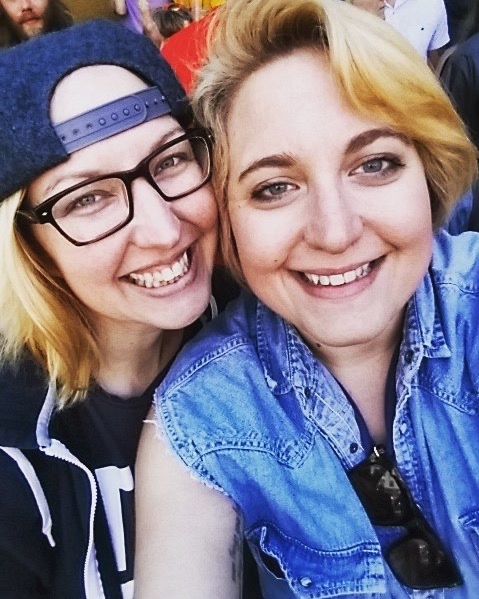
PIP: So your parents were supportive of your sexuality?
MW: Well, my dad and I stopped talking soon after I left the church; my parents are divorced, so it’s easier to not talk to one parent. They’ve been divorced since I was four and he was kind of absent anyway. He hasn’t talked to me in eight years.
But my mom is fine, and my mom’s mom, my Mormon grandma, came to our wedding in June and danced at my wedding. What more can you ask for? It was really sweet.
PIP: Tell us a little about your wife Ashley — how did you meet?
MW: We met at a Halloween party in 2014. I was dressed as Alex Vause and she was Bob from Bob’s Burgers. We just hit it off because she’s from Montana and I’m from Idaho. But we both never know when someone is flirting and it took us a little while to figure it out.
We’d known each other for like two or three months and we booked a two-week trip to Europe together so she could see Sleater Kinney on her birthday. It was fuckin’ rad! I was like, if I travel this well with this person, I can be with them be with them. And it just kept getting better. She proposed on New Year’s 2016. We just got married in June.
PIP: Congratulations! Now can you tell us a little about Beefcake Swimwear? What led you to start the business?
MW: I had a roommate and good friend years ago who wanted a 1920s swimsuit, but couldn’t find one. And I was like, “I’m kinda handy, I can sew, I should try making you one.” I started to try and it was really hard.
But other people, when I mentioned what I was doing — it look me like a year to get around to doing it — they were like, “Oh that’s really cool, I’d be interested in that.” I kept hearing it again and again. And I thought, maybe that’s a viable business idea.
Once I figured out I could not do it myself, because sewing swimsuit material is a nightmare and I have a day job I’d like to keep, I found a manufacturer here in Portland who has zero minimums and was taking on new clients. So I approached them, and they’d never done swimwear before, I’d never done this before, but we embarked on it together.
We did three rounds of prototypes and I mailed them around to people to get their feedback on fit and style. Then we did a Kickstarter campaign to raise the money to really go into production and see if it was really viable. And it was; we hit over 300% of our goal, and shipped swimsuits to five different countries. It was really cool!
I still get notes and letters from people saying that they haven’t worn a swimsuit in 10 years, and they’re so excited to go swimming again, which is amazing and is the whole reason I’m doing this.
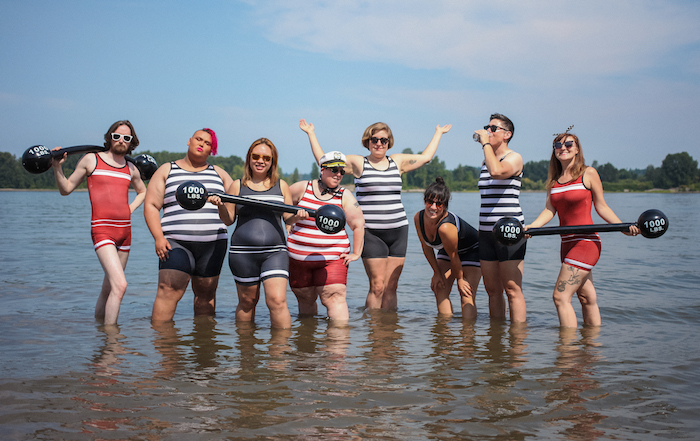
PIP: Can you talk more about that side of things — how Beefcake caters to people who want a more androgynous swimwear option?
MW: Yeah, this was originaly made for the LGBTQ community with the idea of fuck gender norms, fuck these stupid boxes that we’re supposed to fit into. If you have a body and you want to go swimming, this is a swimsuit you can put on your body. I don’t care what body parts you have.
This approach was surprisingly difficult, because all of fashion is so gendered. Even my pattern maker looked at me like I was completely nuts when I said I wanted it to be androgynous.
I was like, I think this is doable, but we’ve been making it up as we go along, and thank goodness the suits are stretchy because bodies come in variety of different shapes and sizes and parts.
The most challenging part is, and the thing I’m still disappointed on, is I haven’t found a way to make a binder or to really put bottoms in it, whether to hold up a cis penis or to pack. I haven’t figured that out and I don’t know that I will. It’s so expensive to create and test prototypes, and then to stock inventory.
That’s another thing I didn’t realize. Everyone’s like, “Oh, it’s an amazing idea, you’re going to get rich!” Um, I’m a year and a half in, and I still have not paid myself. So much for getting rich! Because I’m also really determined to make it as affordable as possible, because most of us in our community are economically disadvantaged for a variety of reasons, most of them systemic.
So I recognize that and I want to make them affordable, but I can’t compete with Target and Walmart, who are making swimsuits overseas. Cheap fashion is only cheap because the people who are making it aren’t paid well, and that’s something we all need to be more educated about. And it’s really frustrating and it’s hard to walk that line between my customers who want something affordable, but what about the people who are making the suits?
That’s been a really hard lesson to learn, and still something that I struggle with. But I think there’s a shift of like, oh, our clothes are made by other humans, and how are they and the environment affected by the manufacturing process? I think people are starting to understand, and the people who do get it are enormously supportive and can’t believe how cheap they are!
PIP: How many designs and colors do you carry?
MW: Right now we have two designs that come in three colors. We have sizes XS through 5X. So all told, if I keep only one of each in stock, I have 120 suits. God bless my wife; our little tiny apartment is just stuffed with swimwear!
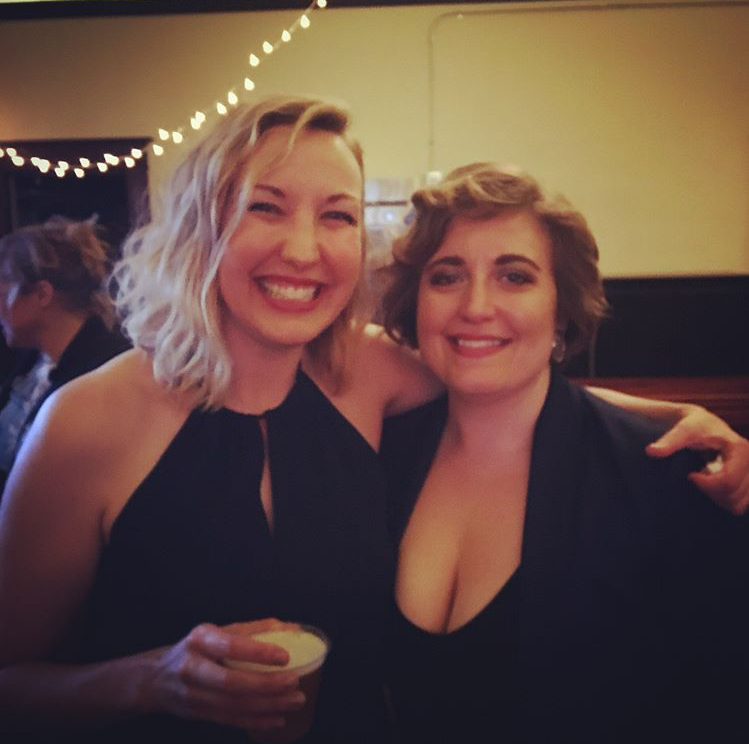
PIP: How did you come up with the name Beefcake Swimwear?
MW: I can’t really remember, but I’m pretty sure it came from butch friends who joke about being beefcakes. It’s a term that is a little queer, and a little retro, and it doesn’t take itself too seriously, so it fit.
PIP: Has it been hard to gain traction with a swimwear business during the winter?
MW: We’ve sold almost 100 suits since we went on sale about a month ago. I have done almost zero advertising; I think I’ve spent $20 on Instagram. But I think we tapped into something people really want. Also, it’s summer in Australia!
That was another really interesting thing — during the Kickstarter campaign, I had LGBTQ folks in mind as the only people who would want these, but there are a lot of others.
About a week into the campaign, we got picked up by some TV show, “RightThisMinute.” They took our Kickstarter video and remixed it and did like commentary over it. I had no idea it was happening. It popped up in my radar because we had like 50 backers overnight and they were all ladies with names like Maude and Susan from midwestern states. I was like, what just happened? So I Googled a bit, and figured it out.
I still don’t really understand how this happened, but it was kind of amazing. A lot of the feedback I get from customers like these — the ones I wasn’t expecting — is that they aren’t into swimwear that’s sexy; they just want swimwear that’s functional and comfortable. I understand that.
I confess, there’s a sneaky part of me that’s like, “Oh cool, I’m getting these older white ladies from the Midwest to buy into this really queer swimsuit company!” It just makes me laugh. I did have one woman who said, “I just can’t get behind something named Beefcake. Have you Googled ‘beefcake’? It’s pornographic!” I said, “It’s not pornography, it’s tongue in cheek,” but she wasn’t having it.
PIP: That’s hilarious! So what’s in store for the future?
MW: This is a journey and these swimsuits are not perfect by any means. I’m still working on them. I’m open to collaborations with other queer designers, or I’d love to start partnerships with people who make binders and who make packers and work together to make some sort of complementary garments; that would be a really cool thing in the future.
I’m hoping to really go on sale with more inventory this spring. It’s kind of been just make as much as I can afford to make, and then sell it. It’s been a wild ride.
Keep up with Beefcake Swimwear on Facebook!
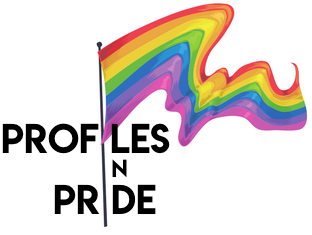
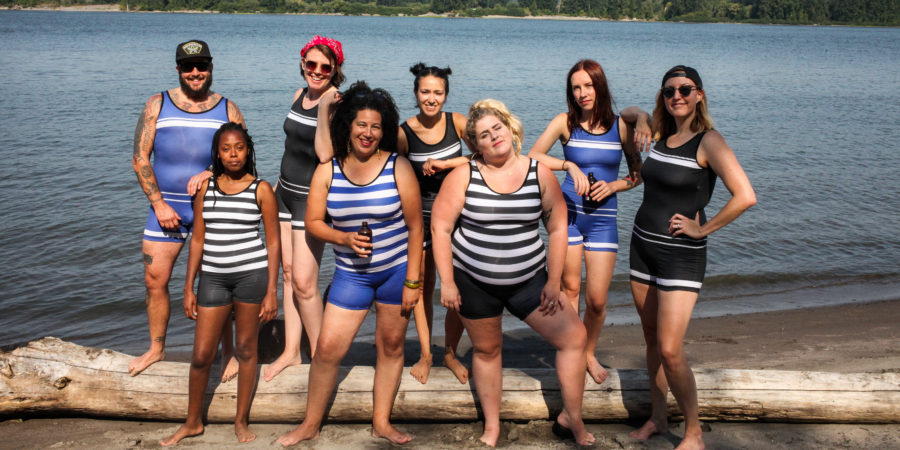
[…] Swimwear is the brainchild of Mel Wells, a self-proclaimed tomboy lesbian and semi-skilled seamstress. After raising more than $35,000 on […]